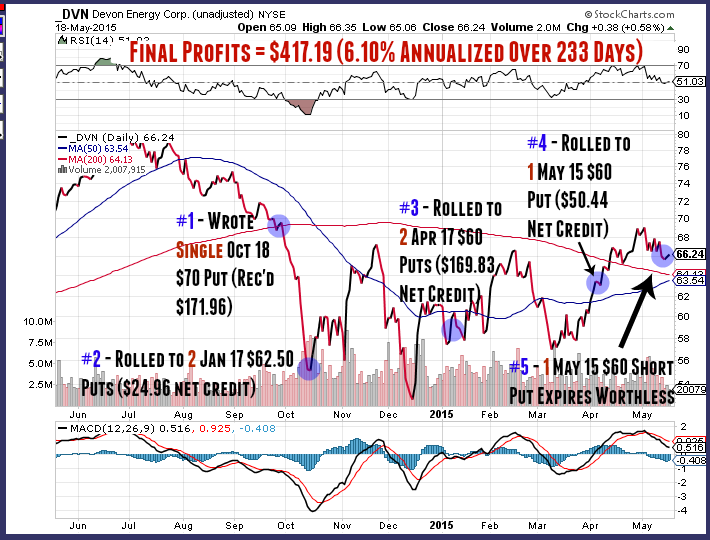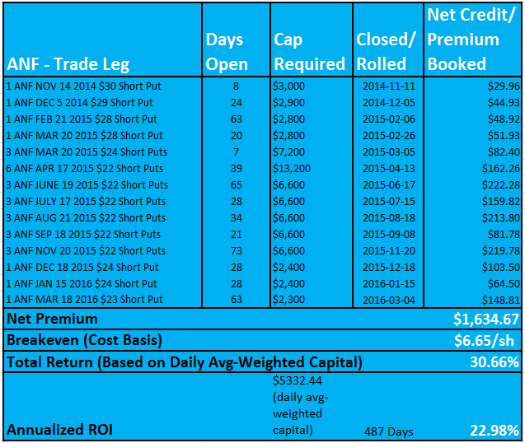The Emotional Impact of Short Put Trade Repair
or
How Not to Feel Like Crap Sticking with an Underwater Trade
It's definitely a contrarian approach, but we in The Leveraged Investing Club don't abandon our wounded trades on the battlefield.
Of course, it helps a great deal that we use a customized put selling strategy that's incredibly forgiving and flexible and which gives us material advantages over other traders and investors in the stock market.
So instead of cutting and running and accepting losses when a trade doesn't work out as we originally expected it would, we rescue and rehabilitate that trade so that we almost always walk away with more money than we started with once the dust has settled.
Again, it helps that we customize and work with a very forgiving strategy, and we manage that strategy as part of larger campaigns vs. seeing and treating our trades as binary, one time events.
Here are three examples . . .
DVN - Devon Energy
In this example from 2014 and 2015, DVN dropped 23.15% on me after I wrote a put on the stock at the $70 strike.
The stock would only partially recover over the duration of the trade, but I still managed to walk away with modest, but respectable 6.10% annualized returns at the end of the day (and on real, cash-secured capital, not margin).
I also used only minimal additional capital repairing the trade, increasing the number of short or naked puts on the stock from one to two over the life of the trade. And even then, I reduced the number of contracts back down to one before the trade concluced.
Successfully - and profitably - repairing the trade also enabled me to exit the position and avoid what would later become another severe leg lower in the underlying stock.
Included in the Sleep at Night High Yield Option Income Course inside The Leveraged Investing Club is a full 15 page case study on this trade.
"Turning Catastrophic Losses Into Respectable Gains" goes into the full details of how I employed the principles of The Leveraged Investing 4 Stage Short Put Trade Repair Formula to convert a catastrophic trade on DVN into a respectfully profitable and successful endeavor without increasing my risk, massively expanding the trade, or using any confusing or overly sophisticated ad justment techniques in the process.
ANF - Abercrombie & Fitch
In this more extreme example, ANF would fall plunge 49.94% from my entry point to its eventual closing low, but in spite of this massive decline, thanks to the incredible amount of premium available on ANF options and my adherence to the 4 Stage Short Put Trade Repair Formula, I would still generate 30.66% total returns, or 22.98% annualized over 487 days.
A quick explanation on how to read the table above . . .
Each leg of the trade was rolled from the previous leg for a net credit.
In other words, I roll the cost of closing out the old leg into the proceeds of the new leg, and received more for selling the new puts than what it cost me to close out the old, expiring puts.
So each net credit becomes official booked option income once the position has been rolled into a new position.
MCD - McDonalds
Finally, here's a less extreme and more run of the mill trade repair example.
In this example, MCD fell around 5% after I wrote a near the money put against the stock.
The stock would eventually rebound over 50 days, but in the meantime, I managed to lower the strike price on the trade from $94 to $92.50 and book very attractive 13.42% annualized returns on my cash-secured capital over those 50 days.
High yield income on a stock that went nowhere over a couple of months.
There's Just One Problem . . .
Obviously, it feels incredible when, at the end of the day, you realize you made decent to great returns betting on a stock that went down - and sometimes by a lot as we've seen above.
Yes, it's great when a difficult trade is over and and we see that we have, in fact, outsmarted and outplayed Mr. Market yet again.
But while we're in the midst of such a trade, it isn't confidence and superiority we often feel but rather turmoil and a sense of ill foreboding.
So how do you handle that inner turmoil if it rears up while you're riding out and repairing a challenging trade?
How to Overcome Trade Repair Queasiness
The trick, I've come to believe, is to try to view the situation as a math equation rather than as an existential threat.
With our customized trade repair process, as long as a stock doesn't trade down to zero, and as long as we don't overleverage to begin with or sell puts on stocks that are at their highs or which have rich valuations, trade repair is pretty straightforward on a simple mathematical basis.
Stress with our trades is like stress in any other area of our life - it's the result of having a feeling of "needing" something or someone to behave in a certain way and then that not happening.
Now, obviously, money is a whole lot easier to make when Mr. Market behaves as we want him to do from the outset.
But, in my view, while he may have size and strength on his side, we have flexibility and math on ours.
Whatever move he makes, we can counter and improve our own standing.
So when we write a put . . .
- If the stock goes up, we lock in an early and easy profit
- If the stock trades flat, we realize our original profit - and find ourselves in position to do it all over again
- If the stock goes down a little, we realize our original profit + we adjust the trade for additional, if smaller profits in the future
- If the stock goes down a lot, we still realize all our previous profits + we adjust the trade for at least minimal future profits + we also lower the price at which we can exit the trade
- The lower the stock trades, the larger our own strike price adjustments, and that means significantly lower (vs. incrementally lower) strike prices at which we can eventually exit the trade while still having engineered at least minimal gains over the duration of the trade
The Big Picture - We're Actually in Control
It may not feel like it at the time, but by continually lowering the strikes and the breakeven on our trades, we're draining the swamp Mr. Market calls home.
And he's a big ol' gator - so it's unlikely that we have to drain the entire swamp (i.e. the stock trades down or close to zero) before we find him, before we begin to see his scales and dead-eyed stare and know just where to aim our rifles.
I get it - that sick visceral feeling we get from our deep in the money short puts is part of our evolutionary past when we had to fear the things in the swamp.
But when we use options this way, we're no longer a primitive resident of said swamp - we're the big dude standing on the edge of the swamp with industrial pumps, a whole lot of firepower, and a fully functional neocortex.
Mr. Market isn't the predator - he's the prey.
Want to start 'gator hunting with us yourself?
This is where you start.
Tweet
Follow @LeveragedInvest

>> The Complete Guide to Selling Puts (Best Put Selling Resource on the Web)
>> Constructing Multiple Lines of Defense Into Your Put Selling Trades (How to Safely Sell Options for High Yield Income in Any Market Environment)
Option Trading and Duration Series
Part 1 >> Best Durations When Buying or Selling Options (Updated Article)
Part 2 >> The Sweet Spot Expiration Date When Selling Options
Part 3 >> Pros and Cons of Selling Weekly Options
>> Comprehensive Guide to Selling Puts on Margin
Selling Puts and Earnings Series
>> Why Bear Markets Don't Matter When You Own a Great Business (Updated Article)
Part 1 >> Selling Puts Into Earnings
Part 2 >> How to Use Earnings to Manage and Repair a Short Put Trade
Part 3 >> Selling Puts and the Earnings Calendar (Weird but Important Tip)
Mastering the Psychology of the Stock Market Series
Part 1 >> Myth of Efficient Market Hypothesis
Part 2 >> Myth of Smart Money
Part 3 >> Psychology of Secular Bull and Bear Markets
Part 4 >> How to Know When a Stock Bubble is About to Pop





